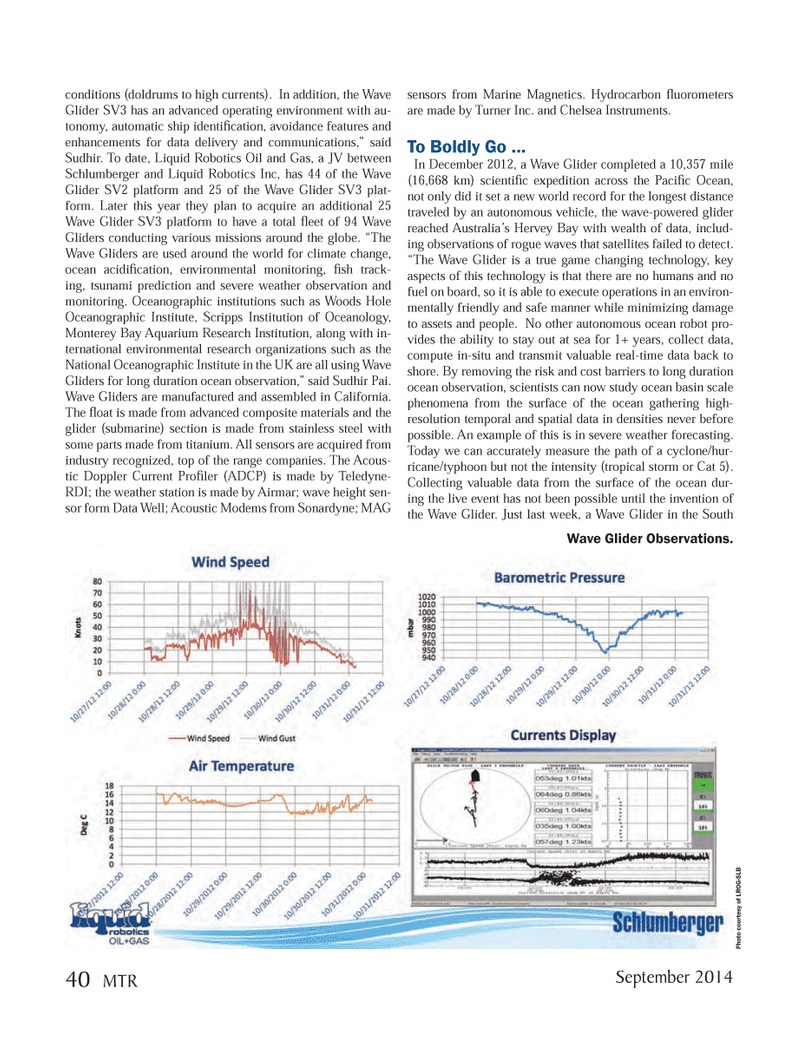
Page 40: of Marine Technology Magazine (September 2014)
Ocean Observation: Gliders, Buoys & Sub-Surface Networks
Read this page in Pdf, Flash or Html5 edition of September 2014 Marine Technology Magazine
conditions (doldrums to high currents). In addition, the Wave
Glider SV3 has an advanced operating environment with au- tonomy, automatic ship identifi cation, avoidance features and enhancements for data delivery and communications,” said
Sudhir. To date, Liquid Robotics Oil and Gas, a JV between
Schlumberger and Liquid Robotics Inc, has 44 of the Wave
Glider SV2 platform and 25 of the Wave Glider SV3 plat- form. Later this year they plan to acquire an additional 25
Wave Glider SV3 platform to have a total fl eet of 94 Wave
Gliders conducting various missions around the globe. “The
Wave Gliders are used around the world for climate change, ocean acidifi cation, environmental monitoring, fi sh track- ing, tsunami prediction and severe weather observation and monitoring. Oceanographic institutions such as Woods Hole
Oceanographic Institute, Scripps Institution of Oceanology,
Monterey Bay Aquarium Research Institution, along with in- ternational environmental research organizations such as the
National Oceanographic Institute in the UK are all using Wave
Gliders for long duration ocean observation,” said Sudhir Pai.
Wave Gliders are manufactured and assembled in California.
The fl oat is made from advanced composite materials and the glider (submarine) section is made from stainless steel with some parts made from titanium. All sensors are acquired from industry recognized, top of the range companies. The Acous- tic Doppler Current Profi ler (ADCP) is made by Teledyne-
RDI; the weather station is made by Airmar; wave height sen- sor form Data Well; Acoustic Modems from Sonardyne; MAG sensors from Marine Magnetics. Hydrocarbon fl uorometers are made by Turner Inc. and Chelsea Instruments.
To Boldly Go …
In December 2012, a Wave Glider completed a 10,357 mile (16,668 km) scientifi c expedition across the Pacifi c Ocean, not only did it set a new world record for the longest distance traveled by an autonomous vehicle, the wave-powered glider reached Australia’s Hervey Bay with wealth of data, includ- ing observations of rogue waves that satellites failed to detect. “The Wave Glider is a true game changing technology, key aspects of this technology is that there are no humans and no fuel on board, so it is able to execute operations in an environ- mentally friendly and safe manner while minimizing damage to assets and people. No other autonomous ocean robot pro- vides the ability to stay out at sea for 1+ years, collect data, compute in-situ and transmit valuable real-time data back to shore. By removing the risk and cost barriers to long duration ocean observation, scientists can now study ocean basin scale phenomena from the surface of the ocean gathering high- resolution temporal and spatial data in densities never before possible. An example of this is in severe weather forecasting.
Today we can accurately measure the path of a cyclone/hur- ricane/typhoon but not the intensity (tropical storm or Cat 5).
Collecting valuable data from the surface of the ocean dur- ing the live event has not been possible until the invention of the Wave Glider. Just last week, a Wave Glider in the South
Photo cour tesy of LR
OG-SLB
Wave Glider Observations.
September 2014 40 MTR
MTR #7 (34-49).indd 40 8/27/2014 9:34:10 AM

 39
39

 41
41
